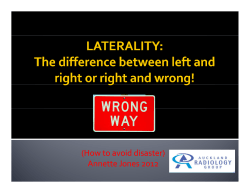
Kyphotic Deformities of the Cervical Spine
Kyphotic Deformities of the Cervical Spine Jan Stulik PHD; Petr Nesnidal MD; Jan Kryl; Tomas Vyskocil MD; Michal Barna Center for Spinal Surgery, University Hospital Motol, Prague, Czech Republic Introduction The development of a cervical kyphotic deformity can be associated with a degenerative disease, trauma, tumour, developmental anomaly and also a surgical procedure. Postoperative kyphosis can develop after both the anterior and posterior surgical approaches. The deformity can also result from systemic diseases, such as ankylosing spondylitis or rheumatoid arthritis. The aim of the study was to make the clinical and radiographic evaluation of a group of patients with kyphotic deformity treated at our department. Material and Methods Retrospective analysis of 102 patients underwent correction of cervical kyphosis at our department between 5/2005 and 4/2010, 90 patients were included in this study with an average age of 56.7 years. In 6 patients kyphosis was caused by an inveterate injury, in 71 by degenerative disease, in 6 by rheumatoid arthritis, and 7 due to previous surgery. Surgery was carried out from the anterior, posterior or combined approach. The surgical outcome was assessed using the Nurick score and Neck Disability Index (NDI), the Visual Analogue Scale (VAS) was used to evaluate pain intensity or paraesthesia. Image 1 a) preoperative lateral radiograph, b) preoperative CT 3D reconstruction, c) preoperative CT sagittal reconstruction, d) preoperative MRI in the sagittal plane Results The average NDI value was 25.5 before surgery and 14.3 and 14.9 at one and two years after surgery. The average pre-operative Nurick score was 0.7; an average post-operative value of 0.6 and 0,6. The average VAS value for neck and radicular pain was 5.7 pre-operatively, and 2.5 and 2.7, respectively. Complete bone union was achieved at 6 months after surgery in 97.8% patients. The average pre-operative value for the cervical curvature index (Ishihara) was -13.7, postoperatively was +15.3. The average pre-operative cervical kyphosis was -14.4 degrees, postoperatively was +13.5. Conclusions The results showed a marked improvement in the patient's quality of life after kyphosis correction, improved neurological status and an improved posture seen on radiograms of the cervical spine. The study also revealed a higher number of potential complications associated, in particular, with corrective osteotomy. The best results were achieved with the combined surgical approach; however, the choice of a surgical method was independent on the patient's clinical status. Images 1 + 2 A 25-year-old man with post-inflammatory kyphosis of the cervical spine measuring 105 degrees which was treated surgically in three steps, first by discectomy of C3–C6, release and traction, subsequently by anterior correction, tricortical graft and bridging by plate in 2+2+2+2 configuration (Atlantis Vision, Medtronic, USA), then from the posterior approach fusion of C3–C6 with polyaxial screwrod fixation (S4 Cervical, Aesculap, Germany) Image 2 a) postoperative lateral radiograph, b) postoperative anteroposterior radiograph Learning Objectives The aim of the study was to make the clinical and radiographic evaluation of a group of patients with kyphotic deformity treated at our department. References 1. ABUMI, K., SHONO, Y., TANEICHI, H., ITO, M., KANEDA, K.: Correction of cervical kyphosis using pedicle screw fixation system. Spine, 24: 2389-2396, 1999. 2. ALBERT, T. J., VACARRO, A.: Postlaminectomy kyphosis. Spine 23: 2738-2745, 1998. 3. BUTLER, J. C., WHITECLOUD, T. S., III.: Postlaminectomy kyphosis. Causes and surgical management. Clin. Orthop. North. Amer., 23: 505-511, 1992. 4. CASPAR, W., PITZEN, T.: Anterior cervical fusion and trapezoidal plate stabilization for redo surgery. Surg. Neurol., 52: 345-352, 1999. 5. HERMAN, J. M., SONNTAG, V. K.: Cervical corpectomy and plate fixation for postlaminectomy kyphosis. J. Neurosurg., 80: 963-970, 1994. 6. ISHIHARA, A.: Roentgenographic studies on the normal patern of the cervical curvature. Nippon Seikeigeka Gakkai Zasshi, 42: 10331044, 1968. 7. MUMMANENI, P. V., DHALL, S. S., RODTS, G. E., HAID, R. W.: Circumferential fusion for cervical kyphotic deformity. J. Neurosurg. Spine: 9: 515-521, 2008. 8. STEINMETZ, M. P., STEWART, T. J., KAGER, CH. D., BENZEL, E. C., VACCARO, A. R.: Cervical deformity correction. Neurosurgery, 60 (Suppl. 1): 90-97, 2007. 9. UCHIDA, K., NAKAJIMA, H., SATO, R., YAYAMA, T., MWAKA, E. S., KOBAYASHI, S., BABA, H.: Cervical spondylotic myelopathy associated eith kyphosis or sagittal sigmoid alignment: outcome after anterior or posterior decompression. J. Neurosurg. Spine, 11: 521528, 2009. 10. VACCARO, A. R., SILBER, J. S.: Posttraumatic spinal deformity. Spine, 26: S111S118, 2001. Image 1 a) preoperative lateral radiograph, b) preoperative CT 3D reconstruction, c) preoperative CT sagittal reconstruction, d) preoperative MRI in the sagittal plane Image 2 a) postoperative lateral radiograph, b) postoperative anteroposterior radiograph
© Copyright 2025





















